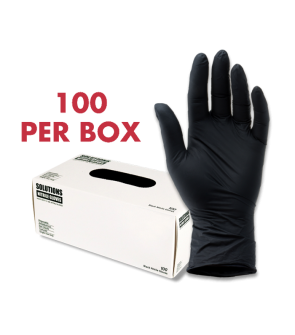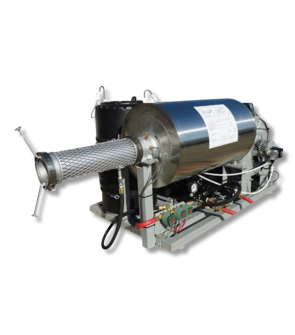Gain access to personalized product screening, the best pricing, rewards, and more!
Most Effective Products
Thermal Foggers
Much like a ULV Fogger, a Thermal Fogger is a piece of equipment for dispersing pesticide products in the air as a mist or fog. However, unlike ULV Foggers, which use cool, low-pressure air currents to produce fog, thermal foggers use heat to vaporize a fogging solution and spray it out of a nozzle as fog.
The primary benefit of using thermal foggers is that the fog is denser and more visible, and the pesticide particles are smaller and hang in the air for a longer duration. They also create more fog faster than your average ULV device or fogging machine, making them better suited to covering large outdoor spaces quickly and efficiently. Thermal foggers are often much larger than ULV models and are generally recommended only for outdoor use.
The underlying principle remains: fill the reservoir with pesticide product, turn the fogging machine on, and aim the spray nozzle at the area you wish to disperse the product into. If you cannot find the information below, contact us; we’re here to help.
Our Recommendation
At Solutions Pest & Lawn, the thermal fogger we recommend most for general use is the Curtis Dyna-Fog Golden Eagle 2610 Fogger. The guide below is tailored to this recommendation, but the general principles discussed apply to most all thermal foggers.

Safety equipment is a must whenever using thermal foggers. Foggers are designed to treat whole areas of space, not just specific surfaces. They suspend droplets of harmful chemicals in the air, which carries them into every corner and crevice. Full skin and eye protection, as well as a full respirator, are required.
See our Protective Equipment page for more on safety equipment. Remember to consult the label of whatever pesticide product you are using with your fogging machine for the minimum required protective equipment. With this particular model of thermal fogger, we also recommend ear protection as it can be quite loud.
User Guide

Step 1: Put on Protective Gear
The first thing you should do before working with any hazardous chemicals is put on protective gear. Again, full skin, eye, and respiratory protection are recommended when fogging. Always remember that all our chemicals have a section on the label detailing the minimum safety requirements for the product. In addition to precautions against damage to the skin, eyes, and respiratory systems, be aware of potential damage to the ears as well. Our recommended thermal fogger runs loud, and some ear protection may be warranted.
Step 2: Fill the Formulation Tank
The next step when using this thermal fogger is to fill the formulation tank with mixed pesticides. Always mix pesticides according to label instructions. Only mix what you expect to use so that there will not be a mixed solution left. Many pesticide concentrate labels do not recommend storing mixed products between uses. Once the formulation tank is ready, ensure the formulation valve is completely closed before starting the fogger to prevent accidental discharge.
Be aware that the formulation tank is under pressure when the unit is on and running. The cap must be airtight for the unit to function, and it must be left alone for at least 15 seconds after stopping the engine to allow the pressure in the formulation tank to escape.
Step 3: Fuel and Start the Fogger
Place the fogging machine away from flammable materials in an uncongested, well-ventilated work area. Remove the fuel tank cap and fill the fuel tank with gasoline. Replace the cap and press and hold the ignition switch, listening for the clicking sound of the electronic ignition system firing the spark plug.
Once you’ve ensured the ignition system is functioning, depress and release the primer bulb until the fuel is visible in the bulb. Depress and release it 3-5 more times if the engine is cold (it hasn’t been operated recently) or only one extra time if you restart a hot engine.
Once the unit is primed, press and hold the ignition and air switches until the engine starts. Once it starts, release the air switch and turn the ignition switch until the engine runs smoothly.
Step 4: Fog
On top of the fogging machine's engine compartment, there is a handle with a small button. This is the formulation ON/OFF button. Below that, there is a switch controlling the metering valve, which sets the fog quality. To fog, set the metering valve to the desired fog quality and push the formulation ON/OFF button to begin releasing fog. Refer to the user’s manual for proper settings and fogging times, which vary based on your specific application.
Inspection and Maintenance
It is recommended that you inspect your thermal fogger unit before each use. In addition to this quick inspection, your unit’s user guide contains detailed maintenance instructions.
Quick Inspection
Before using, fill the fuel tank with gasoline and proceed with standard procedures to start the engine to ensure the unit is operating normally. If no issues arise or leaks are detected, turn off the engine and allow the unit to sit for 15 seconds to a minute while the pressure in the formulation tank escapes. Then, fill the formulation tank with pesticide and ensure the cap is airtight.
Observe the fogging machine to ensure no leaks from the formulation tank. If there are no leaks, continue with the fogging procedures outlined above and detailed in your user guide.
Regular Maintenance
After each use, the formulation system must be flushed by draining the formulation tank, refilling it with one pint of kerosine, no. 2 fuel, or diesel fuel, and then fogging out this liquid until it is completely gone. In addition, check the formulation tank and system for residues. If deposits are built up, increase the fluid used to flush the system after each use.
The engine tube must be cleaned after every four hours of use. The unit includes a cleaning tool for this purpose.
After eight hours, the formulation filter must be cleaned with detergent and water. The engine neck should also be removed and thoroughly cleaned.
After twelve hours of operation, it’s time to check the fuel filter and install a replacement if needed. In addition, the formulation injection nozzle and the formulation injection orifice assembly need to be cleared of any carbon deposits that have built up. The batteries used for the electric starting system must also be checked.
Parts
The Curtis Dyna-Fog 2610 consists of three main parts: the formulation tank, the engine tube, and the engine itself. Each of these is broken down into a multitude of subcomponents. For particular information on these or for a replacement parts guide, please see the user’s manual included with your unit.
The Formulation Tank
The formulation tank is where the mixed pesticide product waits for dispersal. It is kept under pressure until the formulation valve is opened and then forced into the engine tube, mixing into the high-velocity pulsating flow of hot gases. This rapidly heats and breaks the formulation into small particles or vaporizes it, where it is then discharged into the atmosphere out of the engine tube.
The Engine
The engine provides the heat and motion required to create and disperse the fog. In our recommended model, the engine is gas-powered, though it may be electric on other models.
The Engine Tube
The engine tube is essentially an exhaust tube for the engine. The hot gases created by fuel combustion are forced into the engine tube, creating a scorching collection of air and gas. When a pesticide is added, it vaporizes and is forced out of the end of the engine tube along with the engine exhaust as fog. Please be aware the engine tube runs hot during operation and can burn and be a fire hazard if mishandled.
Key Takeaways
What are Thermal Foggers?
- Thermal foggers are fogging machines ideal for dealing with a massive swarm of flying insects, especially mosquitos, in an outdoor context.
- The sheer amount of fog generated with a thermal fogger is unrivaled except by much larger, more heavily specialized equipment.
How Does a Thermal Fogger Work?
- Thermal foggers use heat to generate a vapor of fogging solution to disperse into the air to treat nuisance pests.
- Regular maintenance is necessary to ensure the unit's proper functioning. Follow all maintenance procedures in your product’s user manual closely.









